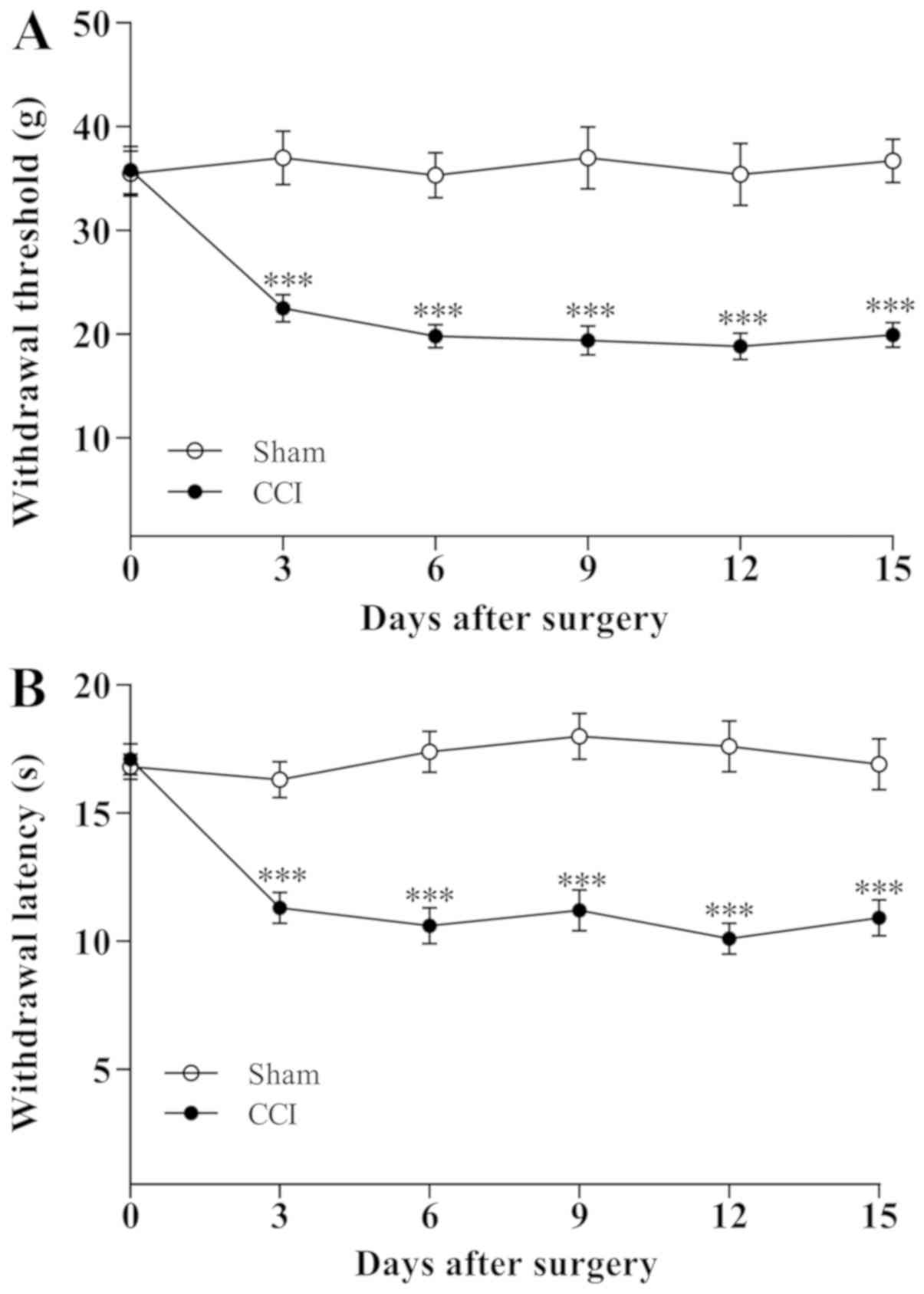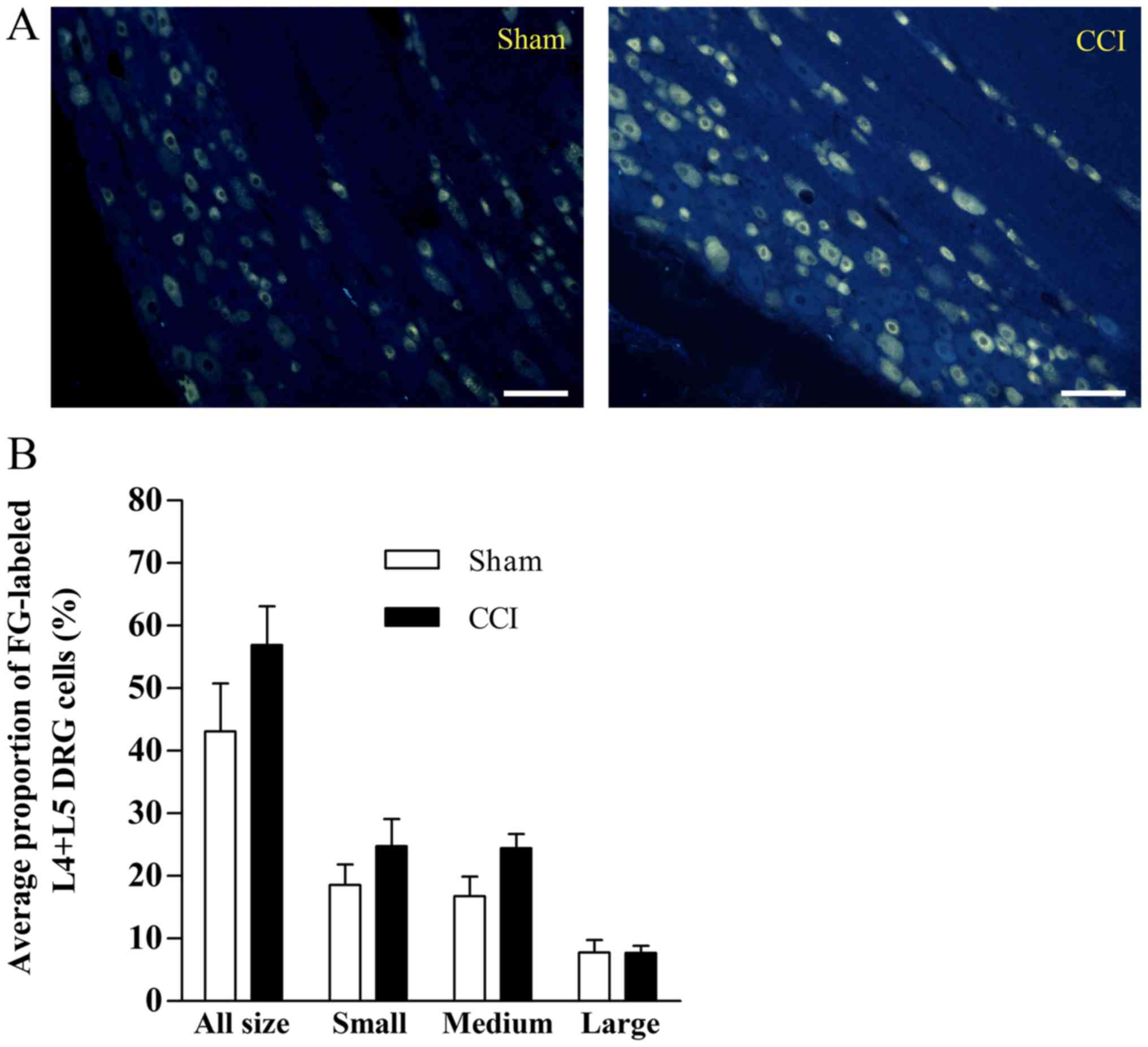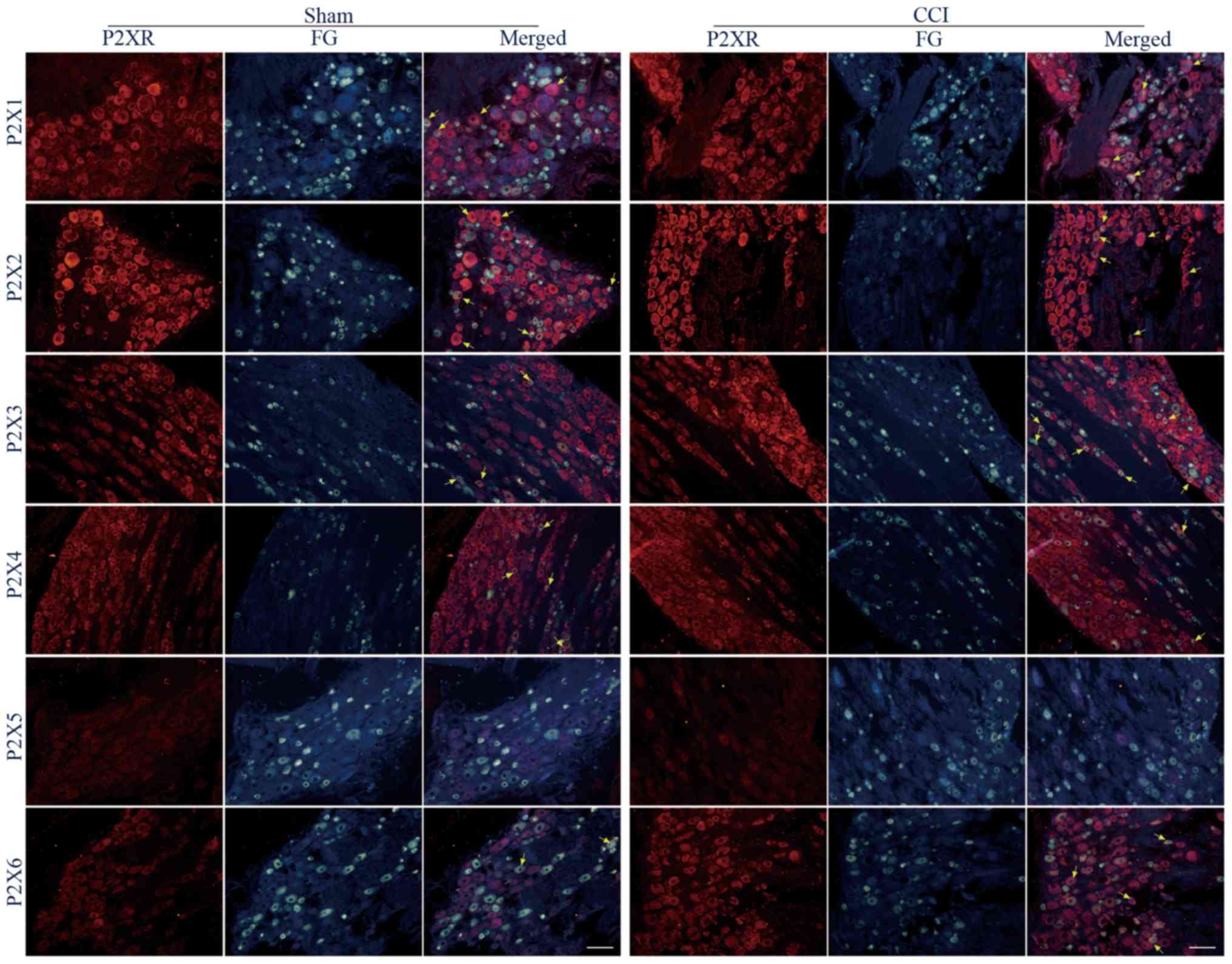|
1
|
Burnstock G: Introduction and perspective,
historical note. Front Cell Neurosci. 7(227)2013. View Article : Google Scholar
|
|
2
|
Burnstock G: Purinergic receptors and
pain. Curr Pharm Des. 15:1717–1735. 2009.PubMed/NCBI View Article : Google Scholar
|
|
3
|
Bennett GJ and Xie YK: A peripheral
mononeuropathy in rat that produces disorders of pain sensation
like those seen in man. Pain. 33:87–107. 1988.PubMed/NCBI View Article : Google Scholar
|
|
4
|
Chaplan SR, Bach FW, Pogrel JW, Chung JM
and Yaksh TL: Quantitative assessment of tactile allodynia in the
rat paw. J Neurosci Methods. 53:55–63. 1994.PubMed/NCBI View Article : Google Scholar
|
|
5
|
Hargreaves K, Dubner R, Brown F, Flores C
and Joris J: A new and sensitive method for measuring thermal
nociception in cutaneous hyperalgesia. Pain. 32:77–88.
1988.PubMed/NCBI View Article : Google Scholar
|
|
6
|
Rose RD and Rohrlich D: Counting sectioned
cells via mathematical reconstruction. J Comp Neurol. 263:365–386.
1987.PubMed/NCBI View Article : Google Scholar
|
|
7
|
Zeng JW, Cheng SY, Liu XH, Zhao YD, Xiao
Z, Burnstock G and Ruan HZ: Expression of P2X5 receptors in the
rat, cat, mouse and guinea pig dorsal root ganglion. Histochem Cell
Biol. 139:549–557. 2013.PubMed/NCBI View Article : Google Scholar
|
|
8
|
Jarvis MF, Burgard EC, McGaraughty S,
Honore P, Lynch K, Brennan TJ, Subieta A, Van Biesen T, Cartmell J,
Bianchi B, et al: A-317491, a novel potent and selective
non-nucleotide antagonist of P2X3 and P2X2/3 receptors, reduces
chronic inflammatory and neuropathic pain in the rat. Proc Natl
Acad Sci USA. 99:17179–17184. 2002.PubMed/NCBI View Article : Google Scholar
|
|
9
|
McGaraughty S, Wismer CT, Zhu CZ, Mikusa
J, Honore P, Chu KL, Lee CH, Faltynek CR and Jarvis MF: Effects of
A-317491, a novel and selective P2X3/P2X2/3 receptor antagonist, on
neuropathic, inflammatory and chemogenic nociception following
intrathecal and intraplantar administration. Br J Pharmacol.
140:1381–1388. 2003.PubMed/NCBI View Article : Google Scholar
|
|
10
|
Wu G, Whiteside GT, Lee G, Nolan S, Niosi
M, Pearson MS and Ilyin VI: A-317491, a selective P2X3/P2X2/3
receptor antagonist, reverses inflammatory mechanical hyperalgesia
through action at peripheral receptors in rats. Eur J Pharmacol.
504:45–53. 2004.PubMed/NCBI View Article : Google Scholar
|
|
11
|
Barclay J, Patel S, Dorn G, Wotherspoon G,
Moffatt S, Eunson L, Abdel'al S, Natt F, Hall J, Winter J, et al:
Functional downregulation of P2X3 receptor subunit in rat sensory
neurons reveals a significant role in chronic neuropathic and
inflammatory pain. J Neurosci. 22:8139–8147. 2002.PubMed/NCBI View Article : Google Scholar
|
|
12
|
Honore P, Mikusa J, Bianchi B, McDonald H,
Cartmell J, Faltynek C and Jarvis MF: TNP-ATP, a potent P2X3
receptor antagonist, blocks acetic acid-induced abdominal
constriction in mice: Comparison with reference analgesics. Pain.
96:99–105. 2002.PubMed/NCBI View Article : Google Scholar
|
|
13
|
Inoue K, Tsuda M and Koizumi S: ATP
induced three types of pain behaviors, including allodynia. Drug
Dev Res. 59:56–63. 2003. View Article : Google Scholar
|
|
14
|
Dorn G, Patel S, Wotherspoon G,
Hemmings-Mieszczak M, Barclay J, Natt FJ, Martin P, Bevan S, Fox A,
Ganju P, et al: siRNA relieves chronic neuropathic pain. Nucleic
Acids Res. 32(e49)2004.PubMed/NCBI View Article : Google Scholar
|
|
15
|
Cockayne DA, Hamilton SG, Zhu QM, Dunn PM,
Zhong Y, Novakovic S, Malmberg AB, Cain G, Berson A, Kassotakis L,
et al: Urinary bladder hyporeflexia and reduced pain-related
behaviour in P2X3-deficient mice. Nature. 407:1011–1015.
2000.PubMed/NCBI View
Article : Google Scholar
|
|
16
|
Souslova V, Cesare P, Ding Y, Akopian AN,
Stanfa L, Suzuki R, Carpenter K, Dickenson A, Boyce S, Hill R, et
al: Warm-coding deficits and aberrant inflammatory pain in mice
lacking P2X3 receptors. Nature. 407:1015–1017. 2000.PubMed/NCBI View
Article : Google Scholar
|
|
17
|
Cockayne DA, Dunn PM, Zhong Y, Rong W,
Hamilton SG, Knight GE, Ruan HZ, Ma B, Yip P, Nunn P, et al: P2X2
knockout mice and P2X2/P2X3 double knockout mice reveal a role for
the P2X2 receptor subunit in mediating multiple sensory effects of
ATP. J Physiol. 567:621–639. 2005.PubMed/NCBI View Article : Google Scholar
|
|
18
|
Chen L, Liu YW, Yue K, Ru Q, Xiong Q, Ma
BM, Tian X and Li CY: Differential expression of ATP-gated P2X
receptors in DRG between chronic neuropathic pain and visceralgia
rat models. Purinergic Signal. 12:79–87. 2016.PubMed/NCBI View Article : Google Scholar
|
|
19
|
Novakovic SD, Kassotakis LC, Oglesby IB,
Smith JA, Eglen RM, Ford AP and Hunter JC: Immunocytochemical
localization of P2X3 purinoceptors in sensory neurons in naive rats
and following neuropathic injury. Pain. 80:273–282. 1999.PubMed/NCBI View Article : Google Scholar
|
|
20
|
Eriksson J, Bongenhielm U, Kidd E,
Matthews B and Fried K: Distribution of P2X3 receptors in the rat
trigeminal ganglion after inferior alveolar nerve injury. Neurosci
Lett. 254:37–40. 1998.PubMed/NCBI View Article : Google Scholar
|
|
21
|
Kage K, Niforatos W, Zhu CZ, Lynch KJ,
Honore P and Jarvis MF: Alteration of dorsal root ganglion P2X3
receptor expression and function following spinal nerve ligation in
the rat. Exp Brain Res. 147:511–519. 2002.PubMed/NCBI View Article : Google Scholar
|
|
22
|
Biggs JE, Yates JM, Loescher AR, Clayton
NM, Robinson PP and Boissonade FM: P2X(3) expression is not altered
by lingual nerve injury. Neurosci Lett. 441:110–114.
2008.PubMed/NCBI View Article : Google Scholar
|
|
23
|
Kim C, Chung JM and Chung K: Changes in
the gene expression of six subtypes of P2X receptors in rat dorsal
root ganglion after spinal nerve ligation. Neurosci Lett.
337:81–84. 2003.PubMed/NCBI View Article : Google Scholar
|
|
24
|
Torres GE, Egan TM and Voigt MM:
Hetero-oligomeric assembly of P2X receptor subunits. Specificities
exist with regard to possible partners. J Biol Chem. 274:6653–6659.
1999.PubMed/NCBI View Article : Google Scholar
|

















